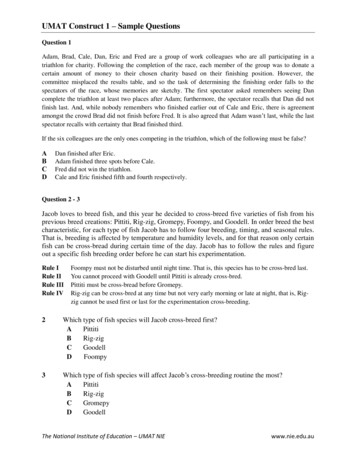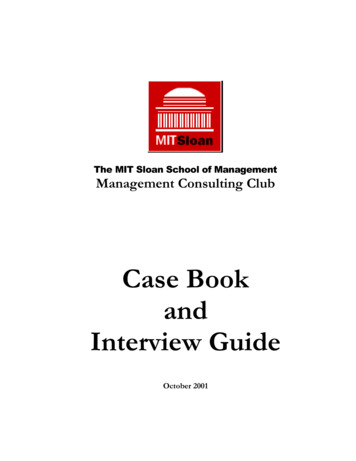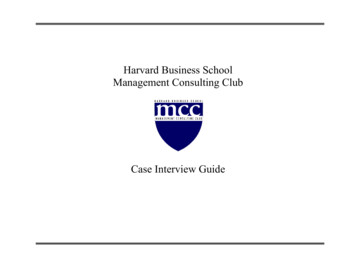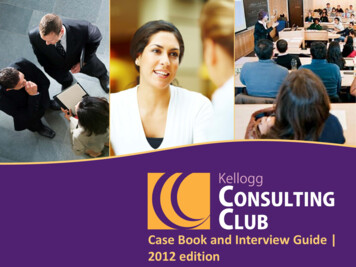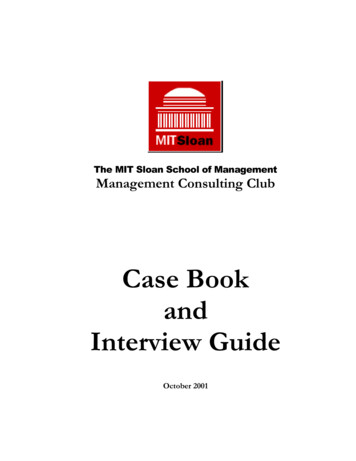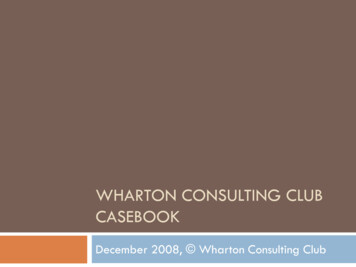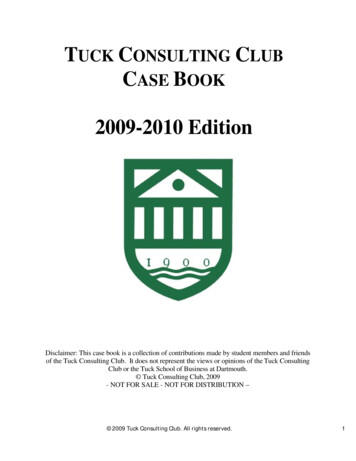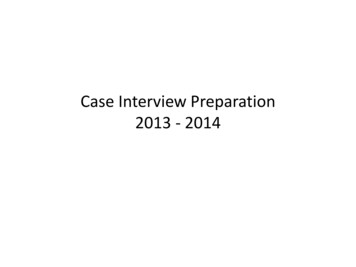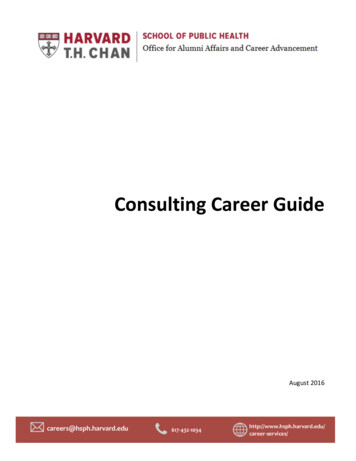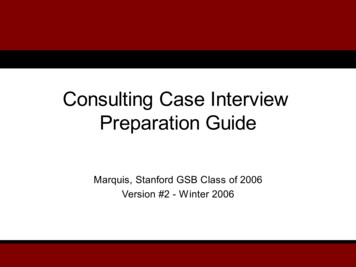
Transcription
Consulting Case InterviewPreparation GuideMarquis, Stanford GSB Class of 2006Version #2 - W inter 2006
About the Author Education––––Princeton University, B.A. in Computer ScienceStanford Graduate School of Business, M.B.A.Stanford University School of Education, M.A. in EducationUniversity of Virginia, M.S. in Management of InformationTechnology Professional Experience– Software Engineer – 1999 to 2004– Summer Strategy Consultant at Accenture – Summer 2005– Associate at McKinsey & Company – Fall 2006 to Present
Table of Contents Prior to the Interview–––––Building Relationships at Your Target FirmsResume PreparationAnswering the “Why Firm X?” QuestionDescribing Your Work ExperienceGenerating a List of Questions Approaching the Case Interview–––––Interview Technique BasicsInterview Practice BasicsMath TricksLearning to “Think Business”Key Business Concepts Case Execution––––Case Execution Tips“The First Four Steps”Types of CasesCase Examples Final Words of Advice
Prior to the Interview
Building Relationships at YourTarget Firms Attend as many events as possible for the firms thatinterest you– Including school/company-wide, affinity group, andregional/office-specific events– At these events, talk to as many people as possible tomake an impression Have a set of good questions to ask firmrepresentatives to show your level of interest in thecompany– Don’t ask about topics that can easily be found on thecompany website) Get the contact info for each person with whom youspeak and follow up with an email after an event
Building Relationships at YourTarget Firms Always make a positive impression when interactingwith company representatives– This includes when attending official companypresentations and dinners, during informal exchanges, andeven at school-sponsored functions– Be on the lookout for deliberate attempts to see how youact when you’re not “on your game” (I fell into this trap several timesduring my MBA summer internship recruiting cycle)– Assume that all interactions with a firm’s employeescould affect your standing, so, unless you alreadyhave an offer in hand, be on your best behavior ATALL TIMES!!!
Resume Preparation Without a prior banking or consulting background, youwill likely have to tailor your resume to appeal to theConsulting firms Instead of focusing on the “must have” skills for yourprevious industry, emphasize the following:–––––Analytical abilitiesExperience in teamsCommunication skillsLeadership/Management experiencesHistory of achieving results Use the “Additional Information” section to bring outqualities/interests to differentiate yourself
Answering the “Why Firm X?”Question Show a “specific” desire to work at Firm X, instead ofsimply a general desire to work in Consulting Learn the “ins and outs” of the company–––––LocationsBusiness areas of specialtyReputation (i.e. what the firm is known for)Career progression and directionCompany culture Research the firm’s competitors to find points ofdifferentiation Give reasons that the firm is a good fit for you andthat you are a good fit for the firm
Describing Your Work Experience Resume “walk-through”– Develop a coherent story for each step along your educational andcareer path It should not seem like a “random walk”– Some firms analyze the “walk-through” as if it were a case Bestructured when describing the sections of your resume W ork experience stories– Allow firms to learn about your experiences in a variety of worksituations– Have four or five unique stories ready to share; Examples include: Led an initiative to a successful/unsuccessful conclusionHad an impact on a team where you were not in chargeWorked in a group where there was internal conflictFound success in a challenging work environmentInitiated change within an organization
Generating a List of Questions It is crucial for the candidate to develop goodquestions to ask the interviewer at the end of theinterview Tips for creating strong questions:– Ask questions beyond standard travel and work-lifebalance issues (Interviewers hear these questions all thetime)– Show that you have done some prior research about thefirm (offices, leadership, areas of focus, career progression)– Ask questions that pertain to your own background(educational/professional, gender, ethnic, etc)– If given an interviewer biography, ask him questions abouthis background and how he was able to leverage it at thefirm
Generating a List of Questions Sample questions– Could you tell me a little about the culture in [FIRM]’s [CITY] office? Howdoes it compare to the culture in the company as a whole?– When thinking about your co-workers, do you consider them to be yourcolleagues, your friends, or both? (this question can tell you a lot about thekind of culture within a company or an office)– As a minority/female consultant, have you ever experienced any negativeinteractions with client representatives where you felt that race was anissue? If so, how did you deal with it? Did your managers support you withyour concerns?– As someone with a tech background, I'm wondering whether my previousexperience will translate well into Consulting. Could you tell me how muchyou've reached back into your prior experience in Technology during yourcareer at [FIRM]?– I really like the fact that your company operates on a generalist model whereconsultants can float around on different types of assignments early in theircareers. What was your experience like when you were in this stage of yourcareer? Did you find it difficult to jump onto client engagements where youhad no prior background and hit the ground running? What sort of support didyour team give you in these cases?
Approaching the CaseInterview
Interview Technique Basics Keep clean and organized notes– Use two separate sheets (landscape-oriented) for yourinformation/analysis and math calculations– W rite in pencil This may seem basic, but being able to erase mistakes can goa long way toward producing clean and easy-to-read notes– W rite as neatly as possible Some companies will collect your notes and evaluate them toget insight about how you structure your thoughts on paper Use tables and graphs during your case breakdown todemonstrate structured presentation of information Get used to using “educated estimates” for valueswhen concrete data is not provided
Interview Practice Basics “Practice makes perfect”– Get started with cases as early as possible to ensure thatyour technique is developed by interview-time Use a good collection of case books and prep guidesto help build your case analysis skills Run through cases with as many classmates andfriends with Consulting experience (either full-time orinternships) as possible– These people usually have experience doing caseinterviews and can provide more specific feedback on yourcase approach– Relying solely on other beginners is basically “the blindleading the blind” and may result in unproductive feedback
Interview Practice Basics Be careful not to “over-practice”– Can result in mental burn-out and drive your thinkingtoward frameworks and past cases you’ve seen, instead ofthinking creatively and independently– Conflicting feedback from practice partners that can beconfusing and negatively affect your case approach Don’t practice with company representatives unlessyou’ve developed a develop case approach– Feedback from company representatives should be reliedupon to sharpen your case skills, not initiate them– It is a waste of a chance to get focused and actionablefeedback (and the consultant’s time) to be unpolishedduring a company case coaching session
Math Tricks Use round numbers wherever you can, especiallywhen you have the chance to pick the numbers Do “ballpark” calculations if possible– Often it isn’t about getting the exact mathematical response– Since there is usually some allowable margin of error, takeadvantage of that and “ballpark” whenever you can Don’t try to do calculations in your head unless you’resure you can solve them correctly– W hen doing calculations in your head, be sure to writeyour solutions down so you can refer to them later
Math Tricks Rule of 10’s and Rule of ½’s– Break difficult numbers into either tens or halves todo quicker calculations– Example: What is 37% of 25,000 25,000/10 2,500 10% of 25,0002,500/2 1,250 5% of 25,0001,250/2 625 2.5% of 25,000From the above, you can approximate the answer:– (3 * 2,500) 1,250 625 9,375 37.5% of 25,000
Math Tricks Example What is the annual U.S. market for chewinggum?– In total number of consumers? Estimate the total U.S. population ( 300 million people) Segment the population based on some metric (age isusually a good metric) Estimate the number of people in each populationsegment Make a guess at the percentage of each segment thatchews gum Complete the math and arrive at a final figure
Math Tricks Example What is the annual U.S. market for chewinggum?– In units (packs) sold? Start with the estimate for total chewing gumconsumers (as determined earlier) Make a guess at the number of packs that an averageconsumer purchases in a given week Multiply the above two numbers to estimate the packsof gum sold each week in the U.S. [Annual packs of gum sold] [W eekly estimate] * 50– There are 52 weeks in a year, but using 50 takes advantage of“ballparking” and the inherent margin of error in estimating
Math Tricks Example What is the annual U.S. market for chewinggum?– In revenue? Start with the annual number of packs sold (asdetermined earlier) Make a guess at the average price of a pack of gum [Annual revenue] [Annual packs of gum] * [Avg. price]
Math Tricks Example What is the annual U.S. market for chewinggum?– In profits? Method #1: Use the annual revenue estimate and applya guessed profit margin– [Total annual profit] [Annual revenue] * [Profit margin] Method #2: Use the average price, apply a guessedprofit margin, and multiply by the estimate annual packssold– [Unit profit] [Average price] * [Profit margin]– [Total annual profit] [Unit profit] * [Annual packs sold]
Learning to “Think Business” Structuring the case problem well and executing onthe math are great, but, to distinguish yourself duringa case interview, you will have to get to the “so what?”ideas in a case (i.e. “Profitability is down because revenues have declined but so what?”) Understanding the interrelations of players within andbetween industries is important to determining theimplications of a business decision or event “Connecting the dots” in a business scenario shouldseem natural and almost second-nature during aninterview– Difficulty in developing key business insights can indicatethat a candidate may struggle on a consulting engagement
Learning to “Think Business” Useful tactics for learning to “think business” include:– Reading business-related periodicals and websites, such asBusinessWeek, the Wall Street Journal, CNN Money, Yahoo!Finance, Fortune, etc.– Watching business-related television networks and shows, such asCNN Headline News, MSNBC, Bloomberg, etc.– When learning about recent business events, figure out the full setof implications of the event, both direct and indirect Example: The OPEC nations decide to restrict the supply of oil– Direct: Gas prices increase in the United States Oil company revenues increase– Indirect: Sales of SUVs decrease Auto companies are compelled to offer more salespromotions on SUVs– Indirect: Airlines raise fares for air travel Some travelers choose to fly less; Airlines maypursue layoffs or salary cuts for employees– Indirect: Use of public transportation increases Revenues for businesses related toautomobile use decline– Indirect: US Federal Government faces pressure to resolve the issue US Governmentmay apply trade sanctions onto the OPEC nations
Key Business Concepts Profitability– Revenues– Costs Industry attractiveness / Market issues– Total size of the market in dollars– Number of competitors Minimum Efficient Scale– Market conditions (shrinking/growing/stagnant) andassociated implications
Key Business Concepts Mergers and acquisitions––––Financials of the deal W ill it be profitable?Product-line synergiesMarket reactionCulture issues Marketing––––PricingPlacement (distribution channels)ProductPromotion
Key Business Concepts Product introduction– Potential market for product Do consumers want it?– Overall profitability of the product Cost to introduce product Expected revenues– Competitor reaction Can they copy it? Do they already have competing products?– Does the new product fit your company and current productline? Does it make sense for your company to introduce theproduct?
Key Business Concepts Other concepts that show deeper business insights– Labor issues Implications of unionized labor and compensation (salary,benefits, etc.)– Long-term contracts– Revenue streams– Costs Fixed vs. Variable Direct vs. Indirect– Supply and demand issues and their effects on pricing– Culture and morale issues– Operational issues
Case Execution
Case Execution Tips Break case problems into distinct segments to create astructured roadmap– Use trees to set up analyses The case question serves as the root and the problem components serveas the branches– Once you’ve presented a roadmap, follow it!!! Be sure that your problem components are “MECE”– “Mutually exclusive”: No overlaps are present between issues to beinvestigated– “Collectively exhaustive”: All potential high-level issue areas havebeen covered by the first-level branches of the tree
Case Execution Tips Example: An automobile dealership is experiencingdeclining profits. What could be the problem?Why is profitability declining?RevenuesPrice CostsQuantity Fixed Variable
Case Execution Tips Don’t be afraid to ask questions if you don’tunderstand something Use frameworks, but don’t let your interviewerrecognize that you are using frameworks Assumptions are powerful, but use them wisely Be quick, but correct, when doing mathcalculations Be confident in your analysis, but be open tochanging direction if guided to do so
“The First Four Steps” Summarize the questionVerify the objectivesAsk clarifying questionsLay out your structureNOTE: The information from this slide and the ten slides that follow were adapted from “Case in Point” by Mark Consentino
Types of Cases Entering a new market– Step 1: Investigate the market to determinewhether entering the market would make goodbusiness sense Assess market attractiveness– Step 2: If you decide to enter the market, you needto figure out the best way to become a player Start from scratch Acquire an existing player Form a joint venture or strategic alliance with anotherplayerNOTE: Adapted from “Case in Point” by Mark Consentino
Types of Cases Developing a new product––––Step 1: Think about the productStep 2: Think about your market strategyStep 3: Think about your potential customersStep 4: Think about financing the projectNOTE: Adapted from “Case in Point” by Mark Consentino
Types of Cases Pricing strategies– Step 1: Investigate the product– Step 2: Choose a pricing strategy Cost-based pricing vs. Price-based costing– Cost-based pricing: Determining the cost of a product, choosing adesired profit margin, and generating a sales price– Price-based costing: Choosing a desired sales price and costingout production to meet that sales price with a desired profit margin Supply and demand forcesNOTE: Adapted from “Case in Point” by Mark Consentino
Types of Cases Growth strategies– Step 1: Ask feeler questions Ask questions to determine the nature of growth thatyour interviewer is looking for (focusing on product,division, or the entire company)– Step 2: Choose a growth strategy Some options are increasing sales, increasingdistribution channels, increasing product line, invest in amajor marketing campaign, diversify products/services,or acquisition of another firmNOTE: Adapted from “Case in Point” by Mark Consentino
Types of Cases Starting a new business– Step 1: Investigate the market to make sure thatentering the market makes good business sense– Step 2: Look at the project from a VC’s point ofview Management teamMarket and strategic planDistribution channelsProductCustomersFinanceNOTE: Adapted from “Case in Point” by Mark Consentino
Types of Cases Competitive response– Step 1: Ask probing questions W hat is the competitor’s new product and how does itdiffer from ours? W hat has the competitor done differently? Have any other competitors picked up market share?– Step 2: Choose a response action Examples: Acquiring the competitor or another playerin the market, merging with a competitor, copy thecompetitor, hire the competitor’s top managementaway, use marketing and public relations to increaseyour profileNOTE: Adapted from “Case in Point” by Mark Consentino
Types of Cases Increasing sales– Step 1: Ask probing questions to gather informationabout the market and our product line– Step 2: Determine a strategy to increase your sales Increase volume Increase revenue from each sale (make buyers buymore) Increase prices Create seasonal balanceNOTE: Adapted from “Case in Point” by Mark Consentino
Types of Cases Reducing costs– Step 1: Ask for a breakdown of costs– Step 2: If any costs are out of line, determine why– Step 3: Benchmark competitorsNOTE: Adapted from “Case in Point” by Mark Consentino
Types of Cases Increasing profits– Step 1: Look at revenues– Step 2: Look at costs– Step 3: Determine whether you want to increasevolume and how to do so Example actions include expanding into new areas,increasing your sales force, increasing marketing,reducing prices, and improving customer serviceNOTE: Adapted from “Case in Point” by Mark Consentino
Types of Cases Turnarounds– Step 1: Gather key information about the companyand its situation– Step 2: Choose an appropriate action Be creative, but base your action upon a structred andwell thought-out planNOTE: Adapted from “Case in Point” by Mark Consentino
Case Example Introduction The following case samples are provided tofacilitate first-level analysis For each case, practice setting up the highlevel tree that could be used to attack theproblem (as shown earlier):– Place the key question for the case at the root ofthe tree– Break the problem into a set of solvablecomponents and assign those components to thetree branches
Case Example Your client owns a professional football teamthat has just won the Super Bowl. Despite theSuper Bowl victory, the team finished theseason with a financial loss for the 5th seasonin a row. What could be the cause of the team’sprofitability problems? What would yourecommend to reverse this past season’sfinancial performance?
Case Example You are the owner of a small, but relativelysuccessful, towing company with a handfullocations throughout the Southeastern U.S.Two recent MBA graduates have approachedyou about purchasing the company. Should you accept the offer to sell yourcompany?
Case Example Your client is an industry-leading securitysoftware company that is considering acquiringa data management software company. Should the client go through with theacquisition?
Case Example Your client is a national chain of fitness centerswith locations in 35 major cities. The companyis thinking of creating a sub-brand of gyms forthe small-town market. Should they do it? What issues come into playwhen making this decision? Under whatcircumstances could the venture besuccessful?
Case Example A publishing company that has traditionallycreated news and entertainment magazines isthinking of introducing a new sports-focusedmagazine. Should they do it?
Case Example You have taken over as the Executiv
BusinessWeek, the Wall Street Journal, CNN Money, Yahoo! Finance, Fortune, etc. – Watching business-related television networks and shows, such as CNN Headline News, MSNBC, Bloomberg, etc. – When learning about recent business events, figure ou

